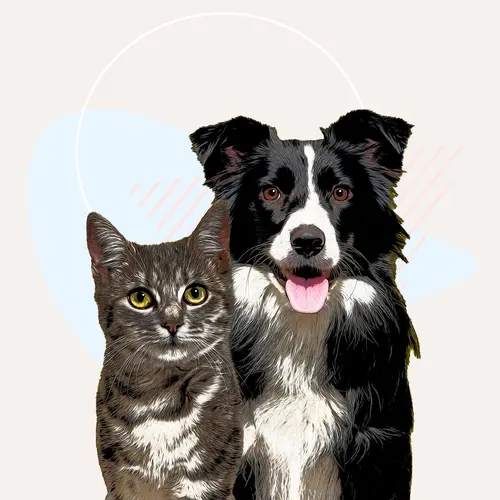The Standardbred horse is the undisputed champion of American harness racing. This breed developed in colonial America and has the oldest breed registry in the U.S. Many horse lovers admire the Standardbred for its flashy gaits, loyal temperament, and versatility. Learn Standardbred horse facts and discover this breed’s rich history.
Standardbred Horse Traits
Physically, the Standardbred horse resembles the Thoroughbred, one of its founding breeds. But the Standardbred also has many unique traits that separate it from its ancestors and other horse breeds.
Standardbred horse conformation. The Standardbred horse is a powerful athlete with prominent muscles, giving it a sculpted appearance. It has a deep chest, sloping shoulders, and clearly discernible withers. Its head has expressive eyes and alert ears. The elegant neck is arched and thin. The horse has a long, flowing mane and a high-set tail.
Standardbred horse colors. This breed comes in a variety of coat colors. The most common Standardbred colors include bay, black, and brown.
Standardbred horse gaits. The Standardbred horse can perform two gaits while racing. Trotters have a diagonal gait, moving their left front and right rear legs simultaneously and vice versa. A trotting Standardbred can move very quickly, but the horse needs special training to perform the gait properly.
Pacers move the legs on each side of their body simultaneously. Pacing is the most popular gait, with over 80% of harness racing Standardbreds competing in this category. The horses wear plastic hobbles while racing that help them maintain the correct gait. A horse that switches from a trot or pace during a race can be disqualified.
Standardbred horse size. The Standardbred is shorter in height but longer and flatter in the body than the Thoroughbred. The average height for this breed is 15.2 hands, and it weighs 800 pounds to 1,000 pounds.
Standardbred Horse Temperament
The Standardbred has a calm, friendly, and loyal temperament. This horse is a bold athlete that’s eager to work and easily trainable. The Standardbred can be competitive and fierce when showing or racing while retaining its good nature and obedience.
These traits make the Standardbred an excellent family companion, pleasure mount, and racehorse.
Standardbred Horse History
The Standardbred horse descends from Messenger, an English Thoroughbred from the famous Darley Arabian bloodline. This stallion was imported to America in 1788. In 1849, a descendant of Messenger produced Hambletonian 10. This horse became the foundation sire of the Standardbred horse, and 90% of modern Standardbreds can trace their lineage to him.
Breeders added the Norfolk Trotter to Hambletonian 10’s bloodlines, giving the Standardbred its distinctive gaits.
Americans mainly used early Standardbreds for harness racing along the roads of major cities. The horses needed to trot a mile within a certain standard to qualify for registration, giving the breed its name.
Originally, horse racers preferred trotters, but pacers became acceptable in the late 1800s. The legendary Standardbred Dan Patch popularized this gait after pacing a swift 1:55 minute mile. Today, harness racing Standardbreds can compete in trotting or pacing races.
Horse racing suffered a temporary setback during World War I. The sport regained popularity in 1938 after the pacer Billy Direct and the trotter Greyhound set new world records. In 1940, Roosevelt Raceway opened on Long Island, and many major cities soon built harness racing tracks.
Harness racing remains a popular sport, though it’s not as well-known as Thoroughbred racing. Most American harness racing tracks are based in the Northeast and Midwest. You can also find tracks in California, Florida, and Canada. Over 300 county fairs regularly host harness races.
What Is Harness Racing?
Harness racing is a competitive sport that often awards purses to winning horses. The Standardbred horse races at the trot or the pace, depending on the horse’s natural gait. The racehorse pulls a driver in a two-wheeled racing sulky. The modern sulky is designed for low wind resistance and stability, allowing the horses to move quickly.
Like Thoroughbred horses, Standardbred racing horses compete in versions of the Triple Crown. Pacing Standardbreds compete in the Cane Pace, The Messenger Stakes, and the Little Brown Jug. Trotting Standardbreds run the Hambletonian, the Yonkers Trot, and the Kentucky Futurity.
In 1996, the United States Trotting Association founded the Standardbred Equine Program to help horses adapt to new careers after they retire from harness racing.
What Are Other Uses of the Standardbred Horse?
This versatile breed excels in many disciplines outside of harness racing. Typical uses of this breed include:
- Barrel racing
- Dressage
- Endurance riding
- Eventing
- Gymkhana
- Hunt seat pleasure classes
- Police mounts
- Saddle seat classes
- Show jumping
- Trail riding
- Western riding
The Standardbred Transition Alliance is a nonprofit organization that matches retired racehorses with owners looking for a family companion or a horse to compete with in other disciplines.
What Health Conditions Affect the Standardbred Horse?
The Standardbred horse is typically a healthy and long-lived breed. The average Standardbred horse lifespan is 30 to 35 years.
Standardbred horses can suffer musculoskeletal injuries while racing. Pulling a sulky around an oval track can cause strain on the horse’s limbs, leading to acute or chronic injuries. Injured horses experience inflammation and pain in the muscle and skin.
One study found that 23% of Standardbred racehorses on Prince Edward Island experienced a musculoskeletal injury in 12 months — 41% of these injuries during a race and 53% during training.
Working with a qualified horse trainer is a good idea to ensure you don’t over-exercise or injure your Standardbred.
Standardbred Horses as Pets
As this Standardbred horse information demonstrates, this breed is adaptable, fast, and friendly. Top show horses may have a hefty price tag, but this breed is generally affordable for the average American family. These traits make the Standardbred a fantastic choice for many horse lovers looking for an accessible but competitive pet.
